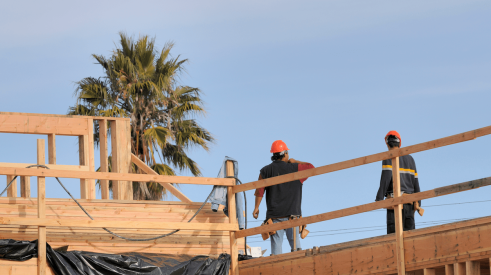The shortage of skilled trade contractors the industry is experiencing now may have a similar Darwinian effect on builders over the next few years as the housing bubble did circa 2008: When things finally get sorted out, only the fittest companies will likely remain, and the steps they took to survive will have made them tougher competitors.
Builders that emerge standing tall from this challenge will be the ones that trade contractors want to work for. They will have created business systems that attract and retain the most professional, well-managed tradespeople—those who consistently deliver high-quality work on time and within budget. Those systems will also make the builder more efficient, with a healthier bottom line.
Working Well With Trades: Good Relations Between Builders and Trades Are All About Systems
More than ever, systems will be what define successful builders.
When it comes to trade relations, the best systems are those that help keep the trades profitable without raising the builder’s costs. “I always tell trades that I want them to make money,” says Ryan Clarke, director of operations at Robuck Homes, in Raleigh, N.C. He says that trades may have accepted low-profit jobs to maintain cash flow during the downturn, but no more.
In fact, trade contractors say there’s enough work that they don’t put up with builders that cut their profits or make their life difficult. “We embrace builders who understand that we’re both in business to make a profit,” says Rich McKenrick, business manager of CS Exteriors, a roofing and siding contractor in Columbia, S.C. “On the other hand, we shy away from those who don’t go beyond simply dictating orders.”
How many builders really grasp this? When we posed that question to trade contractors, most told us that if the industry is getting that understanding, the trades aren’t getting the message. “It’s rare for a builder to think that way,” says Eric Kuntz, owner of Benchmark Quality Builders, a Kansas City, Mo.-area framing contractor. That answer was typical.
What follows may not convince you that you need to make trade relations a priority. But if you’re already onboard with the idea, it will offer the beginnings of a road map.
Home Builder Secrets to Success With Subcontractors
The first point to realize is that if you want to attract and retain the best trades, good intentions by themselves won’t get you there. “If you take an informal approach to this effort, it will be one of the first things to fall off the plate when you get busy or when you’re confronted with a crisis,” Clarke says.
You need to back those intentions up with purpose-built systems. What kinds? To find out, we asked industry quality consultants to identify builders with great trade relations, and then interviewed several of those builders and their trade contractors about what’s working for them.
Although the systems they use vary, four common threads link the builders we spoke with:
1. They have good scopes of work, clear plans and specs, and super-organized schedules.
2. They have formal systems for communicating with trades.
3. They listen to and implement feedback from trades.
4. They pay quickly.
Let’s take these one at a time.

To Work Well With Trades, Builders Should Help Trade Contractors Plan
Builders with the most successful trade relations give trades the information they need to plan ahead. This was the first thing that every single trade named when asked what characterizes the builders they prefer to work with. The information they need includes clear plans and specs, and a schedule that lets them reliably forecast for the coming weeks and months.
It also includes reliable status information on whether tomorrow’s job will be ready. “Our attitude is that we consider dry runs as inconceivable because of the opportunity cost for the trade contractor,” says Jeff Eschliman, VP of operations at Scottsdale, Ariz.-based Maracay Homes. “I want our jobs to be the most ready, the cleanest, and the safest in town. Those qualities are how we market ourselves to the trades.”
Aaron Roan, VP of Inspired Homes, in North Kansas City, Mo., says he relies on the information the company provides trades to make them and the builder more accountable to one another. “If a job is supposed to be ready for you and it’s not, I owe you a trip charge. On the other hand, if you don’t clean up according to scope, I’m going to back-charge you.” He says this has built an atmosphere of mutual respect and that everyone now works to higher standards.
The company also makes its long-term plans available to trades, which was cited as a major reason trades like to work for Inspired. “Aaron hosted a meeting in February where he told us how many houses they would be building this year and outlined the schedule for each month,” recalls Sean Baxter, president of Lawn & Landscape Solutions, in Olathe, Kan. “Seeing that we would be installing 150 irrigation systems helped us plan our hiring.”
Inspired Homes, in North Kansas City, Mo., makes its long-term plans available to trades, which trades cite as a major reason why they like to work for the builder.
While in-person meetings like these are important, trades also want a good online portal. “Inspired’s portal lets you see as far into the future as they have planned. And because it also includes Gantt charts, I have plenty of time to get everything ready for each job,” Baxter says.
The portal also serves as a repository for purchase orders, plans, specs, and other information that trades can use to write accurate estimates and that suppliers can use to build accurate deliveries. “With other builders, it’s not unusual for me to ship the house on the plan only to find out that the actual house is somewhat different,” says Brent Hastie, lumber/millwork sales specialist for Teague Lumber Company, in Grandview, Mo. That ends up costing those builders. “If I know I will have to send trucks back to the job all the time, it’s a factor in my price negotiation.”
One reliable way to provide consistency for trades is to switch to evenflow production. Atlantic Builders, in Fredericksburg, Va., decided to do that by scheduling just three starts per week regardless of sales numbers. The transition took more than a year, but purchasing manager Brian Roinestad says it has ensured that they always have the trades they need on each job. “They know months in advance where they will be so they can plan accordingly,” he says.
Being known for predictability can also lead to more favorable contracts. “Trades factor the cost of dry runs into their pricing, so when I meet with them I explain that they won’t have that problem with us and that I don’t want to pay for other builders’ mistakes,” Roinestad says. Since implementing even-flow, Atlantic gets better pricing from long-term trades.
Working Well With Trades: Define Your Communication Style
Most builders understand that they’ll get better results from trades who feel like they’re part of the team. The builders that actually make happen tend to be those with formal systems for two-way communication. These systems take a variety of forms, from trade councils to webinars and site visits.

How to Make Trade Councils Work
The trade council gets a bad rap because, if not properly led, it can quickly devolve into a gripe session. But two builders we spoke with insist that, done right, it can be a phenomenal management tool.
One of these builders is Essex Homes, in Lexington, S.C., which launched a trade council two years ago that general manager Mike Cancilla says helped the company make a 180-degree turnaround in trade relations. “The former managers had taken an adversarial approach rather than trying to create partnerships, so we needed to rebuild trust,” he says.
Working with Continuum Advisory Group, a Raleigh, N.C., consulting firm, Cancilla set up a meeting with all subs and production people. About 250 showed up. “We started by acknowledging our mistakes, which included not having houses ready for them,” he says. He also shared the company’s goals and plan numbers, and introduced the new management team.
He then scheduled monthly council meetings with the trades who had been most affected by those past mistakes. They included the foundation, framing, mechanical, drywall, and landscaping contractors, as well as a couple of suppliers.
The trade council gets a bad rap because, if not properly led, it can quickly devolve into a gripe session. But, done right, it can be a phenomenal management tool.
Clear agendas are crucial to a council’s effectiveness, so Cancilla insists that each meeting focus on clearly defined problems. The first one the council tackled was variance purchase orders (VPOs). “It was taking too long to get trades back to resolve issues,” he says. The discussion made it clear that the issue was payment. “We worked with the trades on a process to speed up VPO approval so they now get paid more quickly.”
The council has also given him a useful window into the trades’ schedules. “We know when they have a looming schedule crunch, so we can prioritize which jobs we need them to do first,” he says.
Cancilla admits that it took some time for trades to gain enough trust to start speaking their minds. “They didn’t want to get the supers mad at them and also didn’t want to get the supers in trouble,” he says. “We needed to show them that the supers we included in these meetings were the company’s future leaders and that they’re there to learn.” The consultant also met separately with the trades at first, and then relayed concerns to the builder. They became more engaged once they saw those concerns being acted on.
Another benefit of these meetings is that trades get to know one another’s concerns. “There’s more consideration for one another now,” says Stan Sparling, manager at GTG, in Columbia, S.C., which installs Essex’s insulation and gutters. “For example, if we’re putting up gutters and the concrete truck is there, the concrete guys are now more willing to work with us to ensure that we don’t get in one another’s way.”
An outside consultant can be a real help when forming a council, at least until trades know they can speak freely without consequence. The consultant can let the builder know what trades are saying without naming names. “When I meet with them privately, trade partners will talk with me about issues they won’t bring up with the builder,” says Mark Hodges of Blueprint Strategic Consulting, in Haddonfield, N.J. “After one of them takes the risk to open up, the floodgates usually open. I can get honest, specific feedback for the builder.”
Hodges cautions that a council won’t accomplish anything if you’re not willing to address issues such as timely pay, schedule reliability, and good construction documents. “Councils are pointless if you’re still beating up the trades on price, back-charging, and giving them lousy working conditions,” he says. “A good council provides a two-way street of open communication and a shared commitment to solving problems.”
Why Builders Should Consider Going Virtual for Subcontractor Meetings
In-person meetings are important, but webinars and online meetings are more efficient. This has long been common in the corporate world, but few builders take full advantage. Maracay’s Eschliman thinks that’s a lost opportunity. “My trade contractors are having meetings with every builder they work for,” he says. “We want to be respectful of their time.” The company holds just one annual face-to-face meeting with trades, but also hosts a 90-minute webinar every 60 to 90 days.
The webinars include information on the company’s key performance indicators (KPIs), as well as training on topics such as safety and job readiness. The company has also started offering management training in response to requests from smaller trade contractors who want help growing their businesses. Eschliman posts a couple of cell phone numbers at the beginning of each meeting so that attendees can text questions.
Eschliman says that about 85 percent of the company’s trades participate. He credits part of that to scheduling meetings at 9:30 a.m., when field managers are all on the job and mid- to high-level managers have time to tune in.

Home Builder Jobsite Management by Driving Around
One-on-one meetings with trades are always valuable, so some builders schedule them on a regular basis. One of these is Robuck Homes’ Clarke. His typical week includes time to personally visit each of the company’s six neighborhoods.
“I drive out there with no purpose other than to walk the job and talk with people,” he says. “I ask how things are going, what problems, if any, they’re encountering, and their thoughts about the floor plan they’re working on.” He says the trades offer helpful feedback. “The plumber told me that it was taking too much time to run pipe around a particular beam and asked what we could do.” Clarke says the company fixed the plans to make things go more smoothly.
Address the Language Barrier With Building Crews
With so many builders relying on crews from Spanish-speaking countries such as Mexico and Guatemala, language can be a major issue. Dallas-based Dunhill Homes has made it a nonissue by hiring a bilingual construction manager and giving him the title of field relations manager.
Felipe Elizalde says that he spends 90 percent of his time in the field visiting several communities per day. “My job is to keep communication going between the trades and the builder,” he says. “I also follow up with no-shows, negotiate pricing, help the trades with our invoicing system, and make sure they get paid on time.” He also works with trades to identify the underlying sources of problems, such as short material orders.
Feedback from the trades has been positive. “They like having one person they can ask for help with this stuff,” Elizalde says. His work has helped the trades better understand Dunhill’s business plan and has also given the builder a better understanding of how to retain them in a competitive market. “If a trade sees a slowdown in work coming, they will leave to work for another company and we may not be able to get them back when we need them,” he says. Because of the open communication, Elizalde has helped Dunhill understand how to juggle schedules to keep trades busy. “It can take a lot of work, but it’s worth the effort,” he adds.
Ensuring a steady workflow for trades has paid off. “We’ve seen labor shortages in the [Dallas-Fort Worth] market, but those shortages went away for us after we started doing this,” Elizalde says.
To Work Well With Trades, Foster a Partnership Mindset With Your Subcontractors
Getting honest feedback from trades means you can use their insights to solve problems and improve processes. But to be successful at this, you need to listen to and act on what you learn, which means you have to approach trades more as partners than as transactions. Trades say while that’s not the rule, things are getting better. “I would guess that 40 percent of the builders in this market are now starting to understand the partnership model,” says CS Exteriors’ McKenrick.
He adds that Essex is one of the builders he works with that really gets the partnership model. When Richland County began requiring drip edge on roof edges, the builder was worried that an off-the-shelf drip edge would ruin the look of the roof edge, so it asked McKenrick to collaborate with the company’s designers on something more elegant.
Getting honest feedback from trades means you can use their insights to solve problems and improve processes.
McKenrick, a subcontractor, worked with Essex on a custom solution, in which he bent the fascia up over the roof in a way that wasn’t noticeable, then helped get approval from the building department. “It saved the architectural integrity of the house and saved the builder money,” he says. “The only reason we were able to do that was that we had access to the design people.”
McKenrick also says that Essex has implemented feedback from the trade council to make process improvements, such as improving the accuracy of their purchase orders. “In the past, individual items on the POs, like shutters, didn’t always match the plans, so we had to spend a lot of time checking quantities or going back after the fact to install missing items at an extra cost,” he says. Now the builder has fixed its internal processes and is getting the amounts right.
Sparling has also noticed a stronger team spirit since Essex really started listening to its trades. “With some builders, there’s not a lot of communication,” he says, “which gives the trades the feeling that they don’t care about us. However, we really enjoy working for Essex. It’s obvious that they want us to be profitable, so we work hard to make sure that they are, too.”
Money Matters When It Comes to Subcontractor Loyalty
Paying on time is an obvious way to improve trade relations, so we were surprised at how many subs complained about slow payments. Not surprisingly, they prefer to give their loyalty to builders who pay right away.
“Payment has been a big problem with the building industry in the past, and we’ve worked with builders that only paid us when they got paid,” Baxter says. He has become less willing to accept that. “We want to work for builders that have the financial resources to pay vendors on time regardless of where they are in their business cycle.”
Roinestad says that Atlantic makes a point of paying trades within a week. “If the work is done and signed off on, they get a check the next week,” he says. “That engenders a lot of loyalty.” The company also offers financial incentives. For example, it includes a punch package in every framing contract to cover things such as blocking and framing for duct chases, but if the framer doesn’t use the punch package, the builder credits the cost back to them, which is worth about $300. It’s a reward for careful work.
Speaking of incentives, at least one builder has found that budgeting money to help framers expand their businesses is a wise investment. Derek Holtman, training and operations manager at David Weekley Homes, in Houston, says that the company’s divisions can advance funds to trades for costs to start up or expand their business, as the division manager sees fit.
These funds have been used for purposes that range from enabling the painter to buy more ladders to helping the framer get extra hoses and compressors for the additional people he’s hiring to funding costs incurred by a sub who wants to start his own business. “We’ve been able to help our small, independent trade contractors expand, which has helped meet increased production needs,” Holtman says. “We’re making them into better trade partners who want to keep working with us.”
Trade Contractor Loyalty at No Extra Cost
With the possible exception of helping trades with capital needs and hiring a consultant to kick off a council, creating systems that ensure great trade relations should not cost the builder any more than it’s already spending. As we’ve discussed, the improvements can actually save time and money.
Still, some builders worry they will have to pay trades more for loyalty. Charlie Scott, director at Woodland, O’Brien & Scott, a leading customer satisfaction research company, says that’s extremely unlikely.
Scott, who has served as a judge for the National Housing Quality Awards program for 10 years, says that the judging process includes interviewing 15 or 20 of each builder applicant’s trade partners. “I always ask each trade how much additional business they would want from this builder if its volume grew by 20 percent next year. If it’s a high-performing builder, they usually say, ‘all of that business,’” he says. “I also ask how much that builder pays relative to others in that market and have found no correlation between higher pay and loyalty.”
In fact, Scott says he has yet to meet a builder with great trade relations that pays more for the privilege. In some cases, it’s the opposite. “I know of one builder who pays 10 percent less than anyone else in their market, but trades say they make more on that builder’s jobs than on any other,” he says. “That’s because there are no dry runs, no need for secondary completion trips, and no variances and back charges.” Implementing the management systems that bring about these kinds of results will help make a builder and its trades a winning team.
Charlie Wardell, a freelance writer based in southern New England, has covered the business of residential construction for more than two decades.
Advertisement
Related Stories
Trade Contractors
Which States and Construction Trades Rely Most on Immigrant Workers?
California and Texas have higher concentrations of immigrants in their construction workforce, and certain skilled trades also rely more on foreign-born labor than others
Women in Construction
NJ $4M Grant to Help Boost Access to Construction Trades for Women and Minorities
Through a combination of legislation and grant money, the state of New Jersey is taking steps to increase the diversity of its workforce in construction and the skilled trades
Education + Training
Annual Chico Trades Day Provides Students With Hands-on Experience
In Chico, Calif., trades take center stage at annual trades day event that introduces students to skilled trades career options







